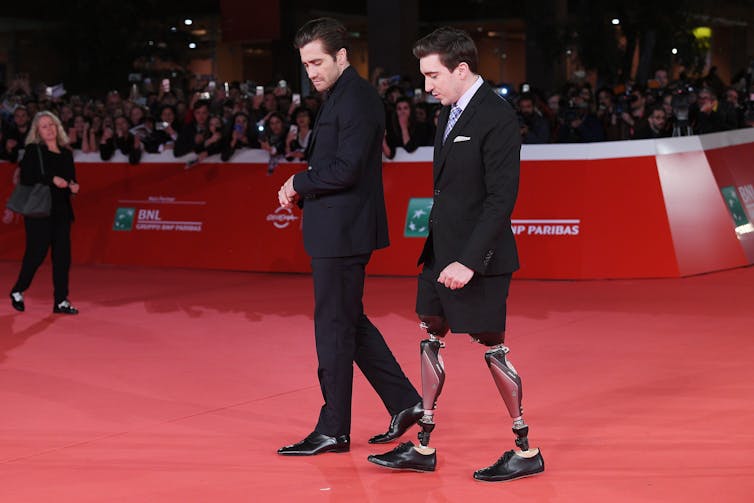

Magda Romanska, Emerson College
The #MeToo and Black Lives Matter movements have forced Hollywood and other artists and filmmakers to rethink their subject matter and casting practices. However, despite an increased sensitivity to gender and race representation in popular culture, disabled Americans are still awaiting their national (and international) movement.
“Disability drag” – casting able-bodied actors in the roles of characters with disabilities – has been hard to dislodge from its Oscar-worthy appeal. Since 1947, out of 59 nominations for disabled characters, 27 won an Academy Award – about a 50% win rate.
There’s Eddie Redmayne’s performance as Stephen Hawking in “The Theory of Everything”; Daniel Day-Lewis’ portrayal of Christy Brown, who has cerebral palsy, in “My Left Foot”; and Dustin Hoffman’s role as an autistic genius in “Rain Man” – to mention just a few.
In recent years, however, we’ve seen a slight shift. Actors with disabilities are actually being cast as characters who have disabilities. In 2017, theater director Sam Gold cast actress Madison Ferris – who uses a wheelchair in real life – as Laura in his Broadway revival of Tennessee Williams’ “The Glass Menagerie.” On TV and in movies, disabled actors are also being cast in roles of disabled characters.
Despite these developments, the issue of representation – what kind of characters these actors play – remains mostly unaddressed. The vast majority of characters with disabilities, whether they’re played by actors with disabilities or not, continue to represent the same outdated tropes.
As a professor of theater and media who has written extensively on the elements of stage drama, I wonder: Are writers and directors finally poised to move beyond these narrative tropes?
Breaking down the tropes
Typically, the disabled characters are limited to four types: the “magical cripple,” the “evil cripple,” the “inspirational cripple” and the “redemptive cripple.”
Magical cripples transcend the limitations of the human body and are almost divinelike. They make magical things happen for able-bodied characters.
In many ways, the magical cripple functions like “the magical Negro,” a term popularized by director Spike Lee to describe Black characters who are usually impoverished but brimming with folk wisdom, which they selflessly bestow on existentially confused white characters.
Like the magical Negro, the magical cripple is a plot device used to guide the lead character toward moral, intellectual or emotional enlightenment. The magical cripple doesn’t learn anything and doesn’t grow because he already is enlightened.
In film, examples include Frank Slade, the blind army colonel who guides young Charlie through the perils of teenage love in 1992’s “Scent of a Woman.” Marvel’s Daredevil character is a perfect example of a magical cripple: A blind person imbued with supernatural abilities who can function above and beyond his physical limitations.
Evil cripples represent a form of karmic punishment for the character’s wickedness. One of the most well-known is Shakespeare’s Richard III, the scheming hunchbacked king.
In a 1916 essay, Sigmund Freud pointed to Richard as an example of the correlation between physical disabilities and “deformities of character.” The trope of the evil cripple is rooted in mythologies populated by half-man half-beasts who possess pathological and sadistic cravings.
More recent examples of the evil cripple include Dr. Strangelove, Mini-Me from “Austin Powers: The Spy Who Shagged Me” and Bolivar Trask in “X-Men: Days of Future Past.”
Then there are inspirational cripples, whose roles equate to what disability rights activist Stella Young calls “inspiration porn.” These stories center on disabled people accomplishing basic tasks or “overcoming” their disability. We see this in “Stronger,” which retells the story of Boston Marathon bombing survivor Jeff Bauman.

Venturelli/WireImage
In the inspirational narratives, disability is not a fact of life – a difference – but something one has to overcome to gain rightful sense of belonging in society.
An offshoot of the inspirational narrative is the redemptive narrative, in which a disabled person either commits suicide or is killed. In movies like “Water for Elephants,” “Simon Birch” and “The Year of Living Dangerously,” disabled characters are sacrificed to prove their worth or to help the protagonist reach his goal.
These characters serve as dramaturgical steppingstones. They are never partners or people in their own right, with their own drives and ambitions. They are not shown as deserving their own stories.
The persistence of these tropes underlies the urgent need to reevaluate the makeup of writers and production teams. Who writes these parts is perhaps more important than who acts them.
Beyond the hero’s journey
There’s a reason these formulaic roles are so prevalent.
For much of the past century, Hollywood storytelling has operated according to the hero’s journey, a dramatic structure that places the white male able-bodied character at the center of the story with atypical characters serving as “helpers” to support his goals.
This narrative model has conditioned audiences to see the helpers as purely functional. The tropes based on this framework define the categories of belonging: who is and who isn’t human, whose life is worth living and whose isn’t.
The one narrative journey that historically allowed the disabled to play a central role depicted them as working toward the symbolic reclamation of their dignity and humanity. In tragic narratives, this quest fails, and the characters either die or request euthanasia as a gesture of love toward their caretakers.
“Million Dollar Baby” and “Me Before You” are two good examples of films in which disabled characters choose voluntary euthanasia, communicating the socially internalized low value of their own lives.
But what if disabled characters already had dignity? What if no such quest were needed? What if their disability weren’t the thing to overcome but merely one element of one’s identity?
This would require deconstructing the conceptual pyramid of past hierarchies, one that has long used disabled characters as props to illuminate conventional heroes.
Carrie Mathison in the series “Homeland” can be thought of as representing this new approach. Carrie, played by Claire Danes, struggles with mental illness, and it affects her life and her work.
But it is not something to overcome in a dramatic sense. Overcoming the disability is not the central theme of the series – it’s not the main obstacle to her goal. Carrie’s disability does give her some insights, but these come at a price and are not magical.
[Deep knowledge, daily. Sign up for The Conversation’s newsletter.]
“Homeland” further breaks the mold by giving Carrie a helper who is an older white male – Saul Berenson, played by Mandy Patinkin.
As we move towards greater gender and race inclusivity at work and in the arts, disability should not be left behind. More complex, more sophisticated stories and representations need to replace the simplistic, outdated and cliched tropes that have been consistently rewarded at the Oscars.![]()
Magda Romanska, Associate Professor of Theatre and Dramaturgy, Emerson College
This article is republished from The Conversation under a Creative Commons license. Read the original article.



















